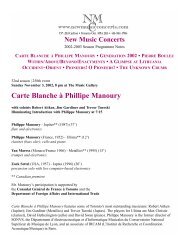2004-2005 Season The Hammerhead Consort - New Music Concerts
2004-2005 Season The Hammerhead Consort - New Music Concerts
2004-2005 Season The Hammerhead Consort - New Music Concerts
Create successful ePaper yourself
Turn your PDF publications into a flip-book with our unique Google optimized e-Paper software.
<strong>The</strong> work is scored for soprano, flute, French horn, bass clarinet, three double-basses and two percussion. One<br />
percussionist must also dance and microphones are used. <strong>The</strong> composer wrote the following note on the piece:<br />
“<strong>The</strong> title comes from two words: orants (people in prayer) with the word alleluia inserted in it. This use of the<br />
trope (a medieval expression meaning a quotation, parenthesis or insertion) reflects the form of the work. <strong>The</strong><br />
text is taken from the first alleluia of the mass for Pentecost, which takes on a special light on the threshold of<br />
this quarter-century:<br />
Emitte spiritum tuum, et creabuntur et renovabis faciem terrae.<br />
(Send out Thy breath and all things will be created and Thou shalt renew the face of the earth.)<br />
“<strong>The</strong> work is intended as a prayer to this ‘breath’ – an antenna directed toward all that is the source of life,<br />
with an idea of blooming and blossoming that belongs to it, giving birth to the alleluia, and animated by two<br />
streams of feeling: the first, all exuberance, rapidity and contrast, is full of movement (melodic, phonetic and<br />
spatial); the second is more continuous and calm, with an exultant serenity. One must also mention the<br />
subjacent idea of rupture, breaking and accident, paradoxical in its ambiguity, because the breaking makes<br />
possible new movements and unexpected departures.<br />
“<strong>The</strong> instrumentation is characterized by the use of three double-basses. Most of the time they use natural<br />
open-string harmonics, an untempered universe which tends to colour the rest of the music. This whole<br />
acoustic aspect is, moreover, dedicated to Pythagoras who first established the relationship between numbers<br />
and harmonic progressions.”<br />
Patricia Green, mezzo-soprano<br />
Mezzo-soprano Patricia Green has gained international renown for her expressive voice, noted for its threeoctave<br />
ease in diverse repertoire. She sang her acclaimed European debut at the 1997 MUSICA Festival,<br />
(Strasbourg, France) in Ligeti’s Requiem with L’Orchestre de Radio-France and went on to open MUSICA in<br />
2000, performing Dusapin’s La Melancholia. She sang her debut at the Concertgebouw in Amsterdam in 1998<br />
with the Dutch Radio Philharmonic. Ms. Green toured France, England and Canada with Autumnleaf<br />
Performance in the opera Kopernikus by Claude Vivier. Recently she sang a lauded <strong>New</strong> <strong>Music</strong> <strong>Concerts</strong><br />
performance under the baton of Pierre Boulez in his work Pli selon pli at the CBC Gould Studio in Toronto<br />
and will sing Heinz Holliger’s Puneigä in April. Ms Green has appeared with conductors Leonard Slatkin,<br />
Peter Eötvös, Zoltan Pesko, Sir David Willcocks, Reinbert de Leeuw and Gustav Meier. Ms. Green has<br />
performed extensively at the Kennedy Center with the <strong>The</strong>atre Chamber Players and sings chamber music with<br />
organizations across Canada and the US. CD recordings are on <strong>New</strong>port Classics, Albany Records, and Live<br />
Unity Productions. She currently teaches at the University of Western Ontario.




